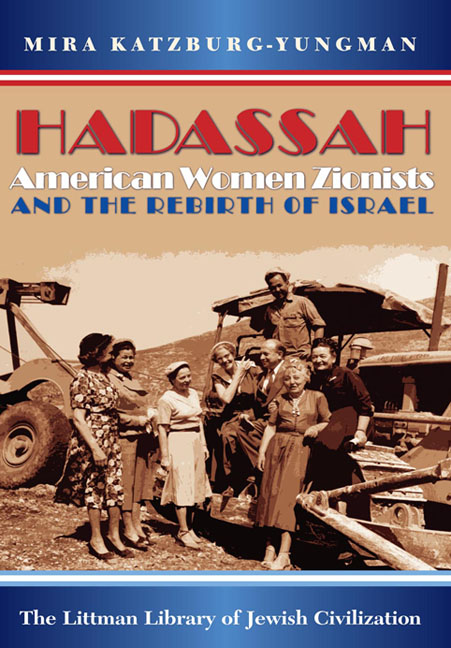Book contents
- Frontmatter
- Dedication
- Preface and Acknowledgements
- Contents
- List of Plates
- Note on Transliteration
- Prologue
- PART I CONTEXTS AND CHALLENGES
- 1 Hadassah, 1912–1933: Finding a Role
- 2 Hadassah, 1933–1947: Responding to Crisis
- 3 The Leadership
- PART II THE AMERICAN SCENE: IDEOLOGY AND PRACTICE
- PART III THE WORLD ZIONIST ORGANIZATION SCENE
- PART IV THE ISRAELI SCENE: HADASSAH AND THE NEW STATE
- PART V HADASSAH IN CONTEXT
- APPENDICES
- Bibliography
- Plate Acknowledgements
- Index
3 - The Leadership
from PART I - CONTEXTS AND CHALLENGES
- Frontmatter
- Dedication
- Preface and Acknowledgements
- Contents
- List of Plates
- Note on Transliteration
- Prologue
- PART I CONTEXTS AND CHALLENGES
- 1 Hadassah, 1912–1933: Finding a Role
- 2 Hadassah, 1933–1947: Responding to Crisis
- 3 The Leadership
- PART II THE AMERICAN SCENE: IDEOLOGY AND PRACTICE
- PART III THE WORLD ZIONIST ORGANIZATION SCENE
- PART IV THE ISRAELI SCENE: HADASSAH AND THE NEW STATE
- PART V HADASSAH IN CONTEXT
- APPENDICES
- Bibliography
- Plate Acknowledgements
- Index
Summary
WHO WERE THE WOMEN who, taking the opportunity offered them by social and historical circumstances, were able to make such a significant collective contribution to the well-being of the Jewish people? What were the resources on which they drew? The research literature deals, albeit not in an entirely methodical or comprehensive manner, with Hadassah's founders and some of the women who headed it until the 1940s. This chapter will discuss the organization's leadership after the end of the Second World War, in the years preceding and immediately following the foundation of the State of Israel.
According to its constitution, Hadassah is directed by its annual convention. This structure crystallized in the early days of the organization. However, in practice it is run by the National Board, which meets monthly and is authorized to manage the organization's affairs between conventions. The board is composed of thirty directors, who stand for election every three years. The Executive Committee manages the organization between National Board meetings, but its activities require the approval of the National Board. Its four officers—the president, treasurer, secretary, and recording secretary—are elected at the annual convention from a list of candidates presented by the Nominating Committee, and its four other members are elected by the board. All officers are elected annually; they may serve until others are elected in their place, but for no longer than four consecutive years in the same position. This limits their power considerably and ensures the flow of new blood among the directors. There is also a rotation system on the National Board. All officers and directors are unpaid and are prohibited from receiving any remuneration from any Zionist group.
Between the end of the Second World War and the end of Israel's first decade of statehood in 1958, Hadassah was headed by twelve of the thirty women who sat on the National Board. They can be divided into three groups according to their socioeconomic and cultural background. One group (the largest) comprised members of families that had emigrated to the United States from eastern Europe. These women had been raised and educated in America, most of them in New York.
- Type
- Chapter
- Information
- HadassahAmerican Women Zionists and the Rebirth of Israel, pp. 54 - 70Publisher: Liverpool University PressPrint publication year: 2011



